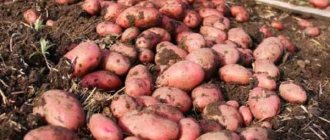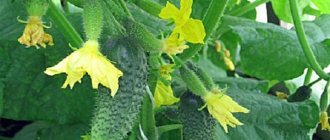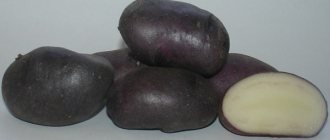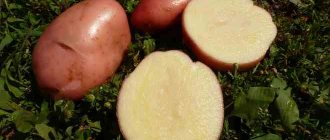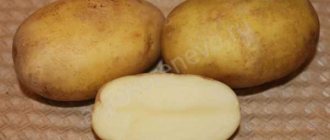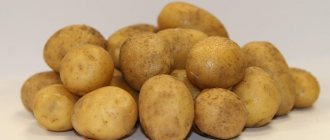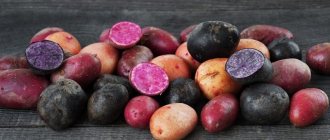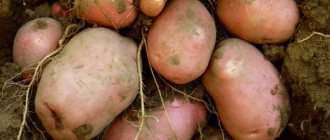Description of the variety
Krona potatoes are a mid-early table variety. Its yield is from 430 c/ha, vegetables are stored for a long time and contain a small amount of starch - up to 12%. The variety is unpretentious in care and tolerates short-term drought well. It can grow without fertilizers, but feeding will not hurt to collect large and high-quality tubers.
On a note . Potatoes contain about 80% water and are rich in vitamins and beneficial minerals. It also contains a lot of provitamin A, which is necessary to support vision.
Origin and development
The variety Krona (Krone) was bred by the German breeding company Bavaria-Saat GBR. This agrotechnical enterprise has been creating new varieties and propagating them since 1987. The company has released about 15 varieties of potatoes that can satisfy the highest consumer demands.
Since Krona potatoes are highly resistant to temperature changes and lack of moisture, they are actively cultivated in many regions of our country.
Distinctive features
Main characteristics of this variety:
- the size of the vegetables is average, weight about 100-130 g;
- the shape of the potato is oval, with a smooth top;
- tubers are neat, balanced in weight and size;
- the shell is yellow, plain, thin and smooth;
- eyes are superficial, small;
- the flesh is yellow;
- starch content does not exceed 12%;
- high content of fiber, proteins, carotene and vitamins.
Video about the variety “Crown”
Unfortunately, there is no video for this variety at the moment. We invite you to watch the video section of our website, where other videos about potatoes and other agricultural crops are posted. We and the entire farming community will be grateful if you send us your video or link about this variety from YouTube or any other video hosting service. If you see this message, it means that we have not yet been able to find a suitable video for this variety.
Similar articles:
Potatoes and all their varieties in detail here → Potato variety "Breeze" - description characteristics reviews photos video
Potatoes and all their varieties in detail here → Potato variety "Bryansk delicacy" - description characteristics reviews photos video
Potatoes and all their varieties in detail here → Potato variety “Borus” - description characteristics reviews photos video
Potatoes and all their varieties in detail here → Potato variety “Bettina” - description characteristics reviews photos video
Potatoes and all their varieties in detail here → Potato variety “Snow White” - description characteristics reviews photos video
Description and characteristics of the plant and crop
Plants of this variety are slightly spreading, the stems are erect. The root system is well developed and fibrous. The small leaves are dark green in color. The inflorescence consists of white flowers, and no seeds are formed at the end of flowering - this is another feature of the variety.
Crohn's potatoes do not degenerate - varietal qualities are preserved and transmitted from the mother's planting material to the next generation. From 10 to 15 tubers are formed under each bush; there are practically no small ones.
Productivity
The Krona variety is a mid-early variety - vegetables ripen 100 days after planting. The yield is high; depending on climatic conditions, vegetable growers harvest from 430 to 650 c/ha.
Interesting .
In total, there are about 4 thousand varieties of potatoes in the world.
Diseases and pests
Struggle
The following pests are considered dangerous for Krona:
If harvesting is not done in a timely manner, potatoes may be affected by late blight.
- To combat aphids , drugs such as Confidor and Actellik are used. All products are used very carefully and only before flowering begins. Among the folk methods they use:
- Treatment with tobacco infusion (500 g diluted in 1 liter of water, boiled for 1 hour, diluted with 10 liters of water before use).
- Spraying with infusion of onion peels (200 g of the substance is poured with boiling water (2 l), left for 2-3 days). You can use garlic peels. The product is also considered effective against lesions of Colorado potato beetles, mites, and wireworms.
- against spider mites with the following preparations: “Vermitek”, “Fitoverm”.
- fight wireworms : “Provotox”, “Prestige”.
- For the Colorado potato beetle, it is recommended to use Confidor, Prestige, and Corado.
- It is recommended to use Fitosporin-M and Ecopin against phytosporosis
Prevention
To prevent infection of Krona potatoes, the following actions are necessary in the form of preventive measures:
- Accounting for crop rotation.
- Proper preparation of the site and planting material.
- Timely weeding, loosening, watering, mulching.
- Place onion peels, wood ash, and peat in the planting holes.
- Proper harvesting and storage of crops.
- Treatment of tubers before planting with disinfectants.
These actions will repel pests - wireworms, spider mites, Colorado potato beetles, aphids, and prevent the development of late blight.
How to grow this variety
Although the variety is unpretentious, proper care will only benefit it. Compliance with all rules and recommendations is the key to a rich harvest.
Dates, scheme and rules of planting
The best predecessors for potatoes are carrots, cabbage, legumes and green manure . In the area where nightshades were grown, there is a risk of common diseases.
The best soil for planting is black soil and sandy loam. In the fall, before plowing, organic fertilizers are applied to the soil. If it is not possible to do this before winter, in the spring add rotted cow manure, peat or ash directly to the holes - in this case, frequent feeding will not be needed.
2-3 weeks before planting, the seed material is germinated: placed in a bright, warm room, pre-treated with a growth stimulant, for example, Epin. One ampoule (0.25 ml) of the drug is diluted in 400 ml of water and sprayed onto the tubers. One ampoule is enough to spray 200 tubers.
For planting, choose healthy, medium-sized seed material. When the air temperature remains at + 10 ° C, they are embedded in the ground.
Planting pattern:
- leave a distance of at least 30 cm between plants;
- the width between rows is maintained at about 60-70 cm;
- the seeds are deepened by 5-8 cm.
On a note. The most suitable planting method for the Crown is considered to be planting on ridges.
To protect plants from sudden frosts, retain moisture during drought, and provide shelter from sunlight, bushes are hilled. During the entire growing season, the event is performed twice:
- the first time when the sprouts reach 15-18 cm;
- the second time 20 days after the first.
Crohn's potatoes are resistant to short-term drought, but require moderate irrigation during bud formation. Due to lack of moisture, small tubers are formed. During the entire growing season, plants are irrigated 2-3 times. Water at the root, since water getting on the foliage will increase the risk of late blight.
Features of cultivation
Crohn's potatoes are also good because they can be planted in any convenient place, regardless of the type of soil. Standard agricultural technology is suitable, as well as all planting methods; you can do without fertilizing. The variety is suitable for beginners in gardening and for those who do not have the opportunity to often visit the dacha.
Important!
To get the highest quality, abundant harvest, it is better to allocate the variety a sunny area with loose, slightly acidic, fertile soil (sandstones and black soil).
The groundwater level must be low, otherwise potatoes must be planted on ridges or ridges. Poor soils are enriched with rotted manure; organic matter must be added when digging.
Tubers must be germinated before planting. Hilling and watering are carried out at normal times. Krona potatoes tolerate short-term drought well, but during long hot periods they need timely moisture. With a lack of water, a large amount of fines is formed in the nests. The variety is fed rarely, moderately, and nitrogen-containing fertilizers are not used.
Collection, storage and use of crops
Seven days before harvest, all tops are cut off. This allows vegetables to get the necessary nutrients and increases their nutritional value. After a week, the potatoes are dug up with a shovel or walk-behind tractor.
The collected tubers are dried in the sun (no more than 2 hours), sorted and stored in a room with an air temperature of about +5...+10°C and a humidity of no more than 90%. The harvest is stored in wooden boxes, bags, nets in the cellar or basement.
Tubers are placed in boxes with small holes. The layer should not exceed 0.5 m so that the lower vegetables are saturated with oxygen and excess moisture evaporates. Containers with the harvest are placed on pallets or planks at a short distance from the walls.
The condition of the potatoes is checked monthly and spoiled tubers are removed so that rotting does not spread to other vegetables. The room is regularly ventilated. The shelf life of this grade is 96% if there is no condensation at the storage location.
Crohn's potatoes work well in French fries, baking, frying, and even freezing mixed vegetables. When boiled, potatoes remain whole, so they are used to make salads. Heat treatment only enhances the taste and aroma of vegetables.
Attention! If the potatoes have turned green, it is better not to eat them. In such vegetables, under prolonged exposure to sunlight, a toxic substance is produced - solanine.
Site selection
When choosing a site for planting potatoes on a hilly area, you should remember that southern and southwestern slopes are the most preferable. Such places are better warmed up by the sun's rays and are well lit. Despite the fact that “Krona” is capable of growing on different soils, the best conditions for it will be loose, slightly acidic, loamy and chernozem soils. The degree of acidity is easily determined by the flowers and herbs growing in the area. For example, the presence of chamomile, wheatgrass, clover and dandelion indicates that the acidity of the soil is optimal and the place is quite suitable for planting potatoes.
The groundwater level should also be taken into account. If the upper aquifers are located too close to the surface of the earth, then potatoes should be grown on specially formed ridges or high beds. We must not forget about the plant’s predecessors, the best of which are carrots, turnips, beets, cabbage and legumes. The limitation for planting “Krona” is the areas where tomatoes were previously grown.
Planting potatoes in the same place every year is unacceptable, as this leads to soil depletion and significantly reduces yields.
Preparation for planting potatoes begins a month before the start of work and consists of selecting planting tubers. To do this, you should sort through the material prepared in the fall and select healthy and even potatoes weighing from 50 to 80 g. Next, it is recommended to dip the selected tubers in copper sulfate diluted in water, then dry and spray with a growth stimulator. Then the tubers need to be laid out in boxes in 2 layers and placed in a bright room with a temperature of 22 Cº. To prevent too rapid germination, the temperature is reduced to 8 Cº at night. After 4 weeks, when the sprouts reach a length of 10-15 mm, you can begin planting.
Tubers should be planted at a distance of 30 cm from each other, leaving at least 65 cm between rows. If the area is large, then the distance can be increased. This will make it easier to care for potatoes and increase the overall yield of the crop. Planting should be done on soil heated to 10 Cº. At lower temperatures, eye growth slows down, and the timing of crop ripening may shift. As a top dressing, a single application of organic fertilizer is recommended in each hole, for which you can use ash, peat or diluted mullein. If planting is carried out in dry soil, half a liter of water should be poured into each hole.
Read also: Where and how to store garlic so that it doesn’t dry out in winter?
The crop does not require constant watering and does not require fertilization, but to ensure a high yield, a number of measures still need to be carried out.
Hilling
The procedure should be carried out after the length of the shoots reaches 15 cm. With earlier hilling, there is a risk of damage to the young plant, which in the future can lead to slower growth and a shift in flowering dates. Work should be carried out very carefully, trying not to touch the stem of the plant.
Hilling up too high can negatively affect the root system, expose it and expose it to the risk of damage by spring frosts. The event should be carried out immediately after rain or watering. This will contribute to the formation of stable ridges and prevent soil from crumbling. Repeated hilling is recommended 20 days after the first.
The crop tolerates short dry periods well, but still requires watering during budding. Low soil moisture can negatively affect the taste of potatoes and contribute to the appearance of a large number of small tubers. It is recommended to water strictly at the root of the plant, since drops on the tops can provoke the development of late blight. In such cases, it is convenient to use a drip irrigation system. In the absence of rain, at least three waterings will be required during the season.
Fertilizer application
Despite the fact that the variety does not require regular feeding, moderate application of fertilizers increases yield and improves the taste and nutritional quality of potatoes. Wood ash in combination with mature humus is considered the best and most affordable remedy. Horse manure is also a good type of feeding. Among fertilizers of mineral origin, it is better to use a phosphorus-potassium additive. The introduction of nitrogen-containing compounds is not recommended, as this contributes to the rapid growth of green mass and the consumption of nutrients and energy for its growth.
A week before digging potatoes, you should cut off all the tops. This will allow the tubers to absorb nutrients and significantly increase their nutritional value. It is recommended to thoroughly dry the harvested potatoes and store them.
Advantages and disadvantages of the variety
Advantages of Crohn's potatoes:
- excellent taste of vegetables;
- the versatility of potatoes in cooking;
- high productivity;
- excellent keeping quality;
- early and friendly ripening of tubers;
- strong immunity to diseases;
- transportability of vegetables;
- drought resistance;
- possibility of growing in different climatic conditions;
- good presentation of tubers;
- undemanding culture for care.
Flaws:
- the capriciousness of the variety in relation to the soil structure;
- intolerance to excess irrigation.
For which regions is it best suited?
The variety is suitable for cultivation in all regions of Russia, as the crop adapts well to temperature changes. In conditions favorable for potatoes, more crops are simply harvested.
Farmer reviews
Summer residents and experienced farmers speak mostly positively about the Krona variety. The culture grows well in the vast majority of regions of Russia.
Olga, Moscow: “Last year I grew potatoes called Krona. The yield pleased me, I didn’t even expect it. I also liked the taste of vegetables. I prepared various dishes from potatoes and simply boiled them as a side dish. The vegetables were stored for several months and during this entire period there were practically no spoiled tubers. The variety has absorbed all the positive qualities. The planting material is excellent, I recommend it to all gardeners.”
Dmitry, Volgograd: “I bought seed material of the Krona variety from a neighbor, he praised it very much. I planted potatoes in almost pure clay, because there was no other place. I was pleased with the result; good potatoes grew. The vegetables are smooth and even, as in the photo. I also liked the taste of vegetables, 5 stars. Now this is my favorite variety. Next year I’ll plant Krona again, and I’ll be distributing planting material to my neighbors myself.”
Natalya, Saransk: “I’ve been involved in vegetable growing for 15 years now. I’m always experimenting with new varieties of potatoes. That year I planted Corona. The variety turned out to be quite productive. The plants did not get sick. The vegetables ripened in about 90 days. The potatoes don't get soggy and hold their shape. I used it to make chips and French fries for the kids.”
Characteristics of potatoes of the Krona variety
It's hard to believe that potatoes became a regular guest on our table just over three hundred years ago. Potatoes have come a long way to become recognized as one of the main plant foods. The Crohn's potato is a classic representative of this species.
Characteristics of potatoes of the Krona variety
It helped overcome frequent famines in medieval Europe, and is rightfully the second bread. It's funny that at first the tubers of this plant were used mainly for making moonshine. Nowadays, potatoes in various forms are included in the menu of any national cuisine. Dishes made from its tubers are appropriate on the table of both the poor and the aristocrat.
Potatoes "Krona": description and cultivation rules
Potatoes "Krona" are well known to Russian summer residents. The variety was obtained as a result of breeding work by German specialists from the Bavaria-Saat GBR company. It quickly took a leading position in our country and became one of the most popular species.
Features of the variety
The German agricultural company Bavaria-Saat GbR, which specializes in potato growing, has developed the unique Kron table potato through many years of selection.
Krona (Krone) is a mid-early ripening variety. It has a relatively short growing season - the full cycle of plant development from planting to harvesting is 100-120 days. A bush of medium height with moderate formation of green mass. Ideal for amateur and industrial cultivation on sandy, loamy and light chernozem soils. It has high productivity: the yield of tubers ranges from 450 to 600 centners per hectare, depending on weather conditions and the climatic zone of cultivation.
Characteristics of potatoes
- large, smooth tubers of regular oval shape, with an average size of 5 cm;
- do not overcook and retain their shape during heat treatment;
- the pulp is juicy, yellow;
- the taste is rich, not watery;
- moderate starch content 12-14%;
- Ideal for preparing many dishes, especially French fries.
Advantages and disadvantages
Crown is one of the most unpretentious crops. It is grown in all climatic zones, from the cold Arctic to the hot deserts of Asia and Africa.
Breeders from around the world have created high-yielding varieties of this plant that have excellent taste and can grow in different types of soil.
The main advantages of the Krona variety are:
- low demands on soil fertility;
- ability to tolerate lack of moisture and short-term temperature increases;
- a small number of substandard tubers in the bush.
- high resistance to diseases and pests;
- excellent keeping quality: crop safety during long-term storage reaches 96%;
- tubers resist mechanical stress well and are almost not damaged during packaging and transportation.
The description of the benefits speaks for itself. It is thanks to these qualities that Corona is in high demand in the planting material market.
Disadvantages include the tendency to form irregularly shaped tubers when grown on dense black soil and rocky soil. It is also possible for the surface of the tuber to crack if there is excess moisture in the soil. This happens in rainy summers or when watering too often.
Characteristic
Krona potatoes are a hardy, mid-early ripening variety that easily tolerates drought. It has a high yield and can withstand storage, transportation and packaging.
Description of the bush
Crohn's potato bushes are medium spreading and erect. The height of the stems is on average 50 cm. The leaves are medium in size, have a matte surface with clear veins, slightly wavy edges and a rich, green color.
Small corollas with large, snow-white flowers form at the tops of the stems. They quickly fall off and few berries are produced. One bush produces 10-15 tubers, as it develops a powerful root system.
Description of tubers
Crohn's tubers are medium-sized, with a diameter of 4 to 7 cm and a weight of 75 to 135 g. They have an oval shape and a smooth surface with inconspicuous, small eyes. The pulp is juicy and yellow. The peel is thin, monochromatic, lemon-colored.
The taste of potatoes of this variety is rich and not watery. Contains a moderate amount of starch, an average of 13%. Therefore, when cut, the tubers retain their color and do not darken. Potatoes are characterized by a high content of nutrients, carotene, proteins and fiber.
Advantages and disadvantages
Krona potatoes are very popular among gardeners in many countries. This is due to the fact that this is one of the most unpretentious varieties that has many advantages:
- Suitable for cultivation in almost all climatic zones. It can be planted in both hot and cold regions.
- Tolerates drought and increased temperatures.
- Undemanding to soil composition. Potatoes can grow in any type of soil.
- Almost all tubers have high commercial quality. There are few small and substandard potatoes.
- High resistance to diseases that are destructive to most potato varieties. The crown is not affected by late blight, potato cancer, scab and rot.
- Good keeping quality. During long-term storage, 96% of the harvest is preserved.
- During transportation, root crops are not damaged or darkened and retain their original appearance.
- The seed material retains varietal qualities and does not degenerate.
The root vegetable is ideal for making frozen mixed vegetables and French fries. Cooks fry it, stuff it and bake it. When cooked, the vegetable does not soften and retains its shape, so it is not suitable for making purees.
There are few disadvantages to this variety of potatoes. When growing crops on dense and rocky soil, some tubers may take on an irregular shape. And if there is excess moisture in the soil and frequent watering, the potatoes can crack or rot. But this can be avoided by providing the potatoes with minimal and rational care.
Productivity and ripening time
Krona potatoes are a mid-early variety. From the planting stage to the ripening of the tubers, it takes from 100 to 110 days, and from the moment of germination - 80-90 days.
Planting this variety brings a bountiful harvest. Its size depends on the climate and weather conditions of the growing region. On average, you can get 54 tons of potatoes per hectare. Maximum yield - 65 t/ha.
Planting potatoes
In order to grow good and tasty potatoes, you need to make an effort, even though this representative of the nightshade family is an unpretentious plant. Compliance with all rules and recommendations guarantees a bountiful harvest.
Soil preparation
Soil that is too dry is not suitable for planting
Potatoes are planted when the soil warms up to 10 0C. At lower temperatures, the germination of buds and the overall development of the plant are inhibited. Despite the fact that Krona potatoes have relatively low demands on soil fertility, it is advisable to apply moderate doses of organic fertilizers - about 120 kg/ha.
The soil should be moderately moist. Excessive dryness in the area leads to slower germination of tubers, and increased moisture content leads to rotting of the planting material.
Planting potatoes
Even though Crohn's potatoes are easy to grow, it takes some effort to enjoy tasty potatoes. Compliance with the peculiarities and rules of agricultural technology guarantees a rich harvest.
Site selection and processing
It is better to choose a site for Krona potatoes on the southern and southwestern slopes. They are well illuminated by the sun's rays, and the earth warms up better on them.
The culture prefers loose and slightly acidic soil. You can determine acidity by plants: chamomile, wheatgrass, clover and dandelion usually grow in such soil. Potatoes of this variety grow well on sandy, chernozem and loamy soils.
If groundwater lies nearby, then vegetable plantings should be placed on ridges or ridges. The best predecessors of potatoes: cabbage, legumes, winter crops, root vegetables. You should not plant potatoes in an area where nightshade crops grew. When digging, you can add a small amount of organic fertilizer to the soil. The best is rotted horse manure.
Tuber preparation
A month before planting potatoes in the soil, you need to prepare planting material. To do this, you need to select healthy medium-sized tubers, weighing from 50 to 80 g. To prevent diseases, the vegetable can be dipped in a solution of copper sulfate. After drying, treat with a growth stimulator.
The next stage is germination. To do this, lay out the planting potatoes in boxes in 1-2 layers and put them in a bright room. For the first 7 days, maintain the temperature at 20-22 o C, then reduce it to 7-8 o C and keep the potatoes for another 4 weeks. Periodically it is sprayed with water and turned over. The vegetable should acquire a dark green color. When sprouts 10-15 mm long are formed, the potatoes can be planted.
Landing rules
After preparing the planting material, you can begin planting it. In this case, it is necessary to take into account some agrotechnical features of potatoes of the Krona variety:
- tubers should be planted at a distance of 25 to 30 cm;
- between rows you need to leave at least 65 cm;
- The potato planting depth should be 4-5 cm.
If the area allows, then the distances between the holes and beds can be increased. This makes caring for potatoes easier.
Potato care
The crown does not require special care and is perfect for “weekend summer residents.” With such minimal physical input, you can grow really good potatoes.
Watering
The variety tolerates lack of moisture and short periods of drought well. However, during the budding period, moderate watering is necessary to obtain a high yield. Low soil moisture can promote “pea-peating,” i.e. the formation of a large number of small tubers and deterioration of their taste, uncharacteristic for this variety.
It is advisable to water in furrows, directly under the root system of plants. Water getting on leaves and stems can trigger an outbreak of late blight.
Fertilizer
Potatoes of the Krona variety do not require frequent feeding, but moderate addition of organic matter and mineral phosphates gives a significant increase in the yield and improves the consumer properties of the tubers. The best organic fertilizers are mature humus and wood ash.
It is not recommended to apply fast-acting nitrogen-containing organic and mineral fertilizers. An increased nitrogen content leads to a large growth of bushes and a decrease in the keeping quality of tubers.
Treatment against pests and diseases
The plant is quite resistant to diseases such as common scab, viral infections, and potato cancer. The relatively short growing season does not allow it to become infected with late blight, the peak of which occurs in the second half of summer.
Diseases and possible pests
Potatoes ripen quite early, so late blight avoids them. For disinfection, it is advisable to treat the soil and tubers before sowing. To reduce the risk of infection, crop rotation is performed. The territory is changed every 3-4 years. The best predecessors of Crohn's will be legumes, cabbage and oilseed radish. The green mass of the bush is attacked by aphids, cicadas and spider mites. But in first place, of course, is the Colorado potato beetle. You can prevent pest invasion by mulching the soil and timely weeding the garden. If the lesions become serious, resort to the use of insecticides. They must be used extremely carefully and always before flowering.
Description of the variety
Roots:
- Medium-sized tubers with a smooth surface;
- The tubers are oval in shape;
- Inconspicuous, small eyes;
- Thin, lemon-colored peel;
- The juicy pulp is yellow when cut;
- The mass of tubers varies from 75 to 135 grams;
- Starch content - 13%.
Escapes:
- The plant is medium spreading and erect;
- The tops grow up to 50 cm;
- Medium green leaves with a matte surface;
- The leaves have clear veins and slightly wavy edges;
- Small corollas with large white flowers that quickly fall off.
Krone seed potatoes, before harvesting:
Advantages, disadvantages and taste
"Krona" has the following advantages:
- High taste qualities of root vegetables;
- Good yield;
- Excellent keeping quality;
- Early uniform ripening of tubers;
- Disease resistance;
- Immunity to mechanical damage;
- Drought resistant;
- Ability to withstand heat and short-term frosts;
- Excellent presentation of root crops;
- Low maintenance requirements.
The Krona variety has no disadvantages.
Variety Krone Elite:
Peculiarities
Characteristics:
- The variety has a medium-early ripening period, with a relatively short growing season - from 100 to 120 days;
- Productivity varies from 450 to 600 centners per hectare, depending on weather conditions and climate of the growing region;
- The seed material does not degenerate for a long time; it is recommended to germinate it first;
- The pulp does not darken when cut. Tubers have a high content of nutrients, carotene, proteins and fiber.
Potato crown:
